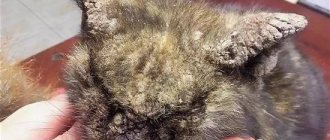With the onset of the warm season, the number of diseases caused by tick bites in cats increases sharply. With the onset of spring, pet owners begin to worry about how to protect their pet from this problem by any means. A tick bite in itself is not so terrible for a cat; dangerous pathogens are contained in the tick’s saliva, which can cause a number of dangerous and sometimes fatal diseases for a cat. Cats that walk through tall grass or dense bushes are especially at risk, where they are especially likely to pick up ticks. The tick that has just attached itself to the cat's skin is about the size of a pinhead. Over time, after he drinks blood, he grows to the size of a bean and is impossible not to notice.
General information about ticks. Ticks (Acarina) are small (0.1-30 mm) arthropods of the arachnid class (Arachnoidea) belonging to the largest group in the arthropod subclass, their number reaches 50 thousand species, most of which do not cause any harm to humans and animals. Ticks that parasitize cats are usually classified as carnivorous parasites, leading to the development of allergies, dermatitis, bacterial and viral diseases. Some ticks that attack cats drink blood, others chew the skin, and others feed on skin secretions and lymph. Cats are most often parasitized by three types of ticks:
Ixodidae (Ixodidae) are the largest ticks, which in a hungry state reach 2-3 mm in length, and after sucking blood - up to 1-1.5 cm. Scabies (internal, ear).
Subcutaneous (demodectic).
Mouth organs (piercing, gnawing, cutting, sucking). In all ticks they are formed by the first two pairs of limbs, chelicerae and pedipalgi; in ixodid ticks they consist of a pair of cutting chelicerae and a hypostome (an outgrowth of the lower edge of the mouth opening, covered with spines), tracheal or cutaneous respiration. Eyes are usually absent, less often there are 1-2 pairs. The stomach is saccular, in blood-sucking ticks with blind outgrowths that fill with blood during blood sucking. The excretory organs are represented by a pair of Malpighian vessels. Blood-sucking ticks have well-developed salivary glands, the secretion of which prevents blood clotting. All ticks are dioecious. The difference between females and males is well expressed, fertilization is internal. Most ticks are oviparous. The six-legged larva is the most characteristic feature of ticks.
The life of a tick can be roughly divided into four stages: egg, larva, nymph and adult. The total lifespan of a tick is about two months. After the tick drinks blood, it falls off and the larva begins to molt. Subsequently, the larva moves to the next stage of development, becoming a nymph; the nymph molts, turning into an adult tick, which is capable of leaving behind offspring. Ticks reproduce thanks to the female's ability to lay eggs. Considering that ticks that attack a cat multiply quickly and create optimal conditions for the development of bacteria and viruses, the owner should not delay treating the cat for ticks.
The process of a tick attacking a cat . Hungry ticks find their prey thanks to the presence of special thermal sensors. A cat passing by a bush or grass on which a tick is sitting becomes an object of attack; the tick makes a jump and, clinging to the hair, remains on the cat. Having latched onto a cat, the tick begins to look for a place on the body that is least covered with hair (skin around the ears, neck, legs, abdominal area, etc.). Further digging into the skin with its tentacles, the tick pierces the skin and begins the process of sucking blood. It becomes almost impossible to tear it away from the cat at this time, and only after the tick has completely drunk blood does it fall off the cat’s skin.
Types of ticks and their descriptions
The tick (Acari) does not belong to insects, as is commonly believed, but to arachnids, which represent the class of arthropods. There are many types of ticks, and they differ from each other in many ways, including their diet. Some species feed on decaying organic matter, others on plant juices, others on insects, etc. They can live in various conditions.
Interesting to know! Few people know that in addition to mites that live on the body of animals in the fur, cats can also have subcutaneous mites, which prefer to settle in the upper layers of the skin or in the ear canal. It is difficult to talk about all the diversity of parasites, of which there are about 1000 species.
In this case, it makes sense to talk about the most common parasites that can be found in both cats and female cats. For example:
- Ixodid ticks (forest ticks), which are distinguished by the fact that they can infect both animals and hosts with infectious diseases.
- Subcutaneous mites (scabies), which infect the upper layers of the animal's skin.
- Ear mites that appear in the ear canal of pets.
How to remove a tick if it has not yet attached itself
When removing a tick, be sure to wear gloves; you can also put a plastic bag on your hand. The tick cannot be crushed; it must be placed in a bottle. Touching a bloodsucker in itself is not dangerous, but there is no guarantee that when caught, the tick will not be crushed, and the causative agents of dangerous infections will not end up on the human skin and mucous membranes.
Any tick that has not attached itself must be burned . You should not throw it in the trash or down the drain - this will not destroy it.
How to tell if a tick has bitten your pet
If the tick moved freely, there is a high probability that it chose a place to bite and did not have time to penetrate the skin. Signs of a tick bite do not have typical differences - the site of penetration will look like a small tubercle of swelling or inflammation with a small pinpoint wound from which bloody fluid may ooze, since the tick's saliva contains substances that prevent blood clotting. The cat may scratch the bite site.
A tick can dig in absolutely anywhere, but more often it is found in secluded places where the skin is thin, the capillaries are close and where it will be difficult to scratch it off with a paw. Therefore, bloodsuckers are most often found:
- in the armpit and groin areas;
- on the stomach;
- behind the ears;
- at the withers;
- on the front of the neck;
- in the area under the tail.
If the tick has burrowed in for a long time, then its head and front legs may already be in the thickness of the skin. The head of this arachnid is fixed very firmly. To the touch, a sucked tick is a soft elastic tubercle located where it was not there before.
You should be careful not to mistake your cat’s nipples for ticks; Cats also have rudimentary (weakly expressed) nipples.
Ways of infection by ticks
There are many ways of infection, so no pet is immune from the appearance of parasites. For example:
- When the owner is with the animals in the park or forest.
- In cases of contact of a healthy animal with a sick one.
- Through contact with contaminated household items.
- The owner can also infect pets with various types of parasites.
This does not mean at all that a cat that practically never appears outside the apartment is protected from the appearance of ticks. When an animal develops blood-sucking parasites, its behavior and health status change noticeably. In this regard, it is recommended to regularly examine pets for parasites.
It is important to know! “Bloodsuckers” not only cause cats and cats a lot of discomfort, but can also infect them with dangerous diseases.
How does infection occur?
The tick is transmitted through saliva, fur, and microtraumas when a sick animal comes into contact with a healthy one.
Infection will occur only if the animal’s immune system is weakened, its metabolism is impaired, i.e. it is at risk, and this is:
- pregnant cats;
- old individuals;
- animals with chronic diseases;
- kittens.
Kittens can become infected from their mother. The tick can also be transmitted through common hygiene products that the cat comes into contact with.
If the cat has a strong immune system, it can become a carrier of the pathogen: it will not get sick, but it can transmit it to other animals.
Subcutaneous mites
Demodex mites or hair mites settle in the upper layers of the skin, as well as in the follicles, and they select areas with the least drooping: on the head, on the neck, on the paws, in the eye area. Parasites can exist in an animal for many years without causing any harm and feeding on dead skin particles.
Demodex mites were first called eyelash or eye mites, which affected livestock. Over time, the parasite appeared in both pets and humans. Demodex mites can infect areas of human skin and also settle on eyelashes.
The tick begins to actively reproduce when a person or animal’s immunity decreases. The symptoms are as follows:
- As a result of the activity of ticks, the animal develops severe itching. As a result, the pet begins to itch constantly.
- There is less and less hair on the affected areas, even to the point of baldness.
- As a result of scratching, small wounds with a crust appear on the animal’s body, as well as festering blisters.
Symptoms of diseases caused by subcutaneous mites:
- Demodectic mange . It affects the upper layers of the skin and is accompanied by unbearable itching, as well as allergic reactions and the appearance of scars on the skin.
- Cat scabies or notoedrosis . As a result of this disease, the animal develops ulcers on the skin and large fistulas, which first appear in the head area and then spread throughout the body, leading to baldness. This type of disease can be transmitted to humans.
- Cheyletiellosis (walking dandruff) . It looks like dandruff formed into clumps containing quite a lot of small mites. When mites move inside the dandruff, they create the impression of movement. Signs of cheyletiellosis include the appearance of scaly nodules on the animal’s back, as well as baldness. The disease can also be transmitted from an animal to its owner.
- Sarcoptic mange (itchy scabies) first appears on the cat's face and gradually spreads throughout the body. As a result of this disease, scabs with crusts begin to appear. This process is accompanied by unbearable itching. Sarcoptoid mites in cats are a specific type of intradermal parasite. A pet can become infected with this type of tick through contact with sick animals, as well as from household items.
Treatment of a particular type of disease is carried out only on the basis of an accurate diagnosis, which is possible in a veterinary clinic. To do this, scrapings are taken from problem areas and the type of parasite is determined.
On a note! The earlier the diagnosis is made, the easier it is to cope with the disease. Mild forms of the disease are often cured by simply increasing the immunity of animals, which is associated with proper nutrition and care.
In cases where the disease is advanced and progresses, these methods of disposal are used.
- Animals are bathed in special shampoos.
- The hair on the affected areas is removed (cut), after which acaricidal preparations are used, in the form of ointments and drops of Fungin, Iruksovetin, Saphroderm, Amitrazine, etc.
- Bacterial lesions are treated with a course of antibiotics prescribed by a veterinarian.
- Increased immunity is associated with the use of vitamin complexes and supplements, such as Ligfol. The use of this drug allows you to stimulate regenerative processes in the body of animals, increase immunity, and accelerate wound healing.
- In cases of infection by fungal pathogens, the veterinarian prescribes Ivermentin subcutaneously.
- It is imperative to carry out preventive actions in relation to other pets that may have come into contact with the patient.
- The cat should be quarantined for up to a month.
- We should not forget about disinfecting the premises, as well as household items. For this purpose, acaricidal drugs like “Delta Zone” and others are used.
how to treat subcutaneous mites or demodicosis
Diseases of cats caused by subcutaneous mites
Notoedrosis (pruritic scabies) – Notoedrosis is a chronic invasive disease of cats, clinically accompanied by dermatitis in the scalp, itching, scratching and hair loss.
Etiology. The causative agent of Notoedrosis in cats is the sarcoptic mite Notoedrosis cati. Its morphology is somewhat similar to mites of the genus Sarcoptes. The body of sexually mature ticks is round in shape and dirty gray in color. It has a body length of 0.14-0.45 mm. The proboscis is horseshoe-shaped, the anus is located on the dorsal side, and in females there is also a copulatory opening. The legs of the tick are short, thick, and cone-shaped. Male ticks have bell-shaped suckers on conical rods (ambulacras) on the 4th pair of legs. In females, the 3rd and 4th pair of legs do not have bell-shaped suckers. Itches parasitize and multiply in passages that they gnaw in the deep parts of the stratum corneum of the skin, directly bordering the malpighian layer.
Developmental biology, epizootological data, pathogenesis, clinical picture, diagnosis, differential diagnosis, treatment and prevention are described in our article - Notoedrosis (pruritic scabies) in cats.
Feline demodicosis is a chronic parasitic skin disease in cats caused by the microscopic worm-like mite Demodex cati.
Etiology. The causative agent of demodicosis, being itself an endoparasite, is localized in the hair follicles and sebaceous glands. It is half a millimeter long and has a transparent body with poorly defined boundaries between the cephalothorax and abdomen. It has short legs with hooks at the ends. The oral apparatus is equipped with a gnawing type proboscis. When a cat is infected with demodicosis, the parasite first penetrates the skin. At the site where the tick gnaws through the skin, it leaves a pronounced concentric spot. Having penetrated the skin, mites begin to feed on skin cells, and the mites multiply intensively. For more information about demodicosis in cats, see our article – Demodicosis in cats.
Otodectosis or ear scabies is a chronic invasive disease of cats caused by parasitic otodectosis mites on the inner surface of the ears and in the external auditory canal.
For more information about the disease, see our article – Otodectosis in cats.
The appearance of ear mites in cats
Ear scabies or otodecosis is a disease when microscopic mites “Notoedres cati” settle in the ear canal of a cat. In such cases, the pet experiences constant discomfort, shakes its head and scratches its ears.
It is important to know! If you examine the ears of an animal, you can see dried elements of ticks in the form of crusts. At the same time, you can note their unpleasant odor.
If such foreign elements are detected, the following should be done:
- Mechanically free the ear canals from crusts by using disinfectant solutions based on furacillin, camphor alcohol or a solution of hydrogen peroxide (diluted).
- Give your cat vitamins and immunomodulatory components.
- Regularly instill medicated drops such as tsipam or otoferonol into your pet's ears. To evenly distribute the medicinal substance, you should massage the cat's ears.
- It is possible to administer a one-time injection of the drug Ivermen against ticks, which has an anthelmintic and arachno-entomocidal effect. Thanks to this injection, it is possible to get rid of the disease much faster. It is advisable to have a specialist give the injection, as you need to choose the right dosage.
- Wilkinson's ointment, which is based on an acaricidal substance, is used to treat the skin of the affected areas.
It will take at least a month of treatment to get rid of ear mites. After the disappearance of the main symptoms, the procedures should be continued for another week, no less.
Important fact! To prevent the animal from interfering with the procedures, a special cap is put on it. This will speed up the cat's healing process and also prevent scratching of the ears.
If the disease is not treated in time, it turns into otitis media with purulent discharge, which often leads to the death of the animal due to damage to the meninges.
Traditional methods of getting rid of ear mites in cats are effective in the initial stages of the disease. To clean the ears of animals, infusions of various herbs are used. For example:
- Green tea tincture. To prepare the product, you need to take 2 teaspoons of dry green tea and pour a glass of boiling water over it. The product must be cooled before use. A few drops (no more than 3) are instilled into each ear for a month and a half, depending on the severity of the lesion.
- Almond oil is used after cleaning the ears. After instillation, it is advisable to massage the ears.
- Using ointment prepared at home. To do this, take 3 tablespoons of vegetable oil and a clove of garlic. The cat's ear canals are lubricated with this ointment daily. In this case, you need to ensure that there are no allergies.
What does an ear mite look like in a cat, cat otodectosis symptoms video
Possible complications
In the absence of proper treatment, subcutaneous mites in a cat can cause a number of negative consequences:
- development of pathogenic microflora inside the body,
- improper formation of hair follicles,
- chronic necrosis processes on the skin of an animal,
- general intoxication of the cat’s body.
The animal becomes thin, emaciated, and takes on an unkempt, patchy appearance. He is plagued by frequent respiratory and gastrointestinal diseases.
Ixodid ticks: methods of control
From spring to the end of summer, quite dangerous representatives of arthropods - ixodid ticks - are active. The size of these parasites is not at all large, and they look similar in appearance to small spiders, while their body is covered with a chitinous shell. When it hits an animal, it moves around on the body for a couple of hours, looking for a suitable place to bite. A hungry parasite, if it has just appeared on a cat’s body, can be detected and destroyed.
When it digs into the body and begins to suck blood, the parasite increases in size to one and a half centimeters, while a hungry tick is not large in size, only 4 mm, no more.
Animals that frequently visit the street can easily “pick up” a tick in the grass or other thickets of vegetation. Sometimes a cat can get rid of parasites on its own, but there are times when it cannot do this.
It is important to know! The most evil, because hungry ixodid ticks are in the spring and autumn.
Ticks have a unique oral apparatus, which consists of a proboscis that can pierce human skin. After this, the parasite clings tightly to the skin and injects an anesthetic substance. Therefore, the cat does not feel the moment of the bite and the parasite can be detected only after a few hours, or even days. The longer a tick remains on an animal's body, the more difficult it is to get rid of it.
Ixodid ticks are particularly dangerous parasites that can infect an animal or person with terrible diseases. For example:
- Piroplasmosis. The disease is dangerous because the number of red blood cells in the blood decreases. As a result, general intoxication of the animal’s body manifests itself, body temperature rises, general weakness appears, and the animal refuses to eat. If effective treatment is not started in a timely manner, the animal will die.
- Hemobartonellosis. This disease is a form of infectious anemia. It can also cause chronic ailments of internal organs.
- Theileriosis or hemosporidiosis. As a result of the lesion, the functioning of the circulatory system is disrupted, which provokes hemorrhages and blockage of blood vessels and further death of the animal.
- Tularemia, which provokes damage to the lymph nodes, intoxication of the body and blood poisoning. Possible death of the pet.
- Worm eggs, which is the most common problem.
What to do if a tick bites a dog or cat
If you notice that a parasite has attached itself to your pet, the bloodsucker must be removed immediately.
Tatyana Shmonina
veterinarian, work experience - more than seven years
It is necessary to take the animal to the nearest veterinary clinic or call a doctor at home in order to properly remove the tick, treat the wound, and immediately submit the parasite for analysis. If this is not done, the bite may result in death.
If it is not possible to take your pet to the doctor, try removing the bloodsucker yourself: the procedure is practically no different from removing a tick from a person.
To do this, you will need a twister, fine-tipped tweezers or thread.
If your dog or cat won't sit still, ask someone to hold it. Otherwise, you risk accidentally crushing the parasite or tearing its body away from its head.
How to get rid of ticks from an animal?
When a tick digs into the skin and begins to become saturated with blood, then most often it becomes noticeable, since it significantly increases in size. In order to rid your cat of the parasite without consequences, you must adhere to a number of rules. For example:
- First of all, you need to protect yourself to avoid contact with the parasite. To do this, just wear rubber gloves and then wash your hands thoroughly.
- It is not recommended to drip oil or other substances onto the parasite, as this can lead to premature infection.
- To remove a tick from a cat, you will have to use special Tik Twister tweezers. This will allow you to remove the entire tick without any consequences.
- Using a thread for this requires great skill, otherwise the tick can be torn apart, damaging it.
- If the head of the parasite still remains under the skin, then it is better to treat the wound with an antiseptic. This is the only way to avoid infection.
- If the tick is pulled out entirely and remains alive, it is better to send it to the laboratory for analysis.
- To destroy a removed tick, it is better to place it in a jar of alcohol. Under no circumstances should it be crushed. Even after being flushed down the toilet, they do not die due to the “air sac”.
HOW TO REMOVE A TICK FROM A CAT
The tick has been removed, what next?
Cats are at much lower risk of contracting any of the diseases compared to dogs. Symptoms of infection appear in cats after 2-3 weeks. During this period of time, it is necessary to carefully monitor the behavior of a pet that has been bitten by a tick.
It is important to know! Young kittens, due to their still weak immunity, are most susceptible to the negative effects of tick bites.
Symptoms of infection may include fever, apathy, loss of appetite, weight loss, diarrhea or vomiting, cough, shortness of breath, pink urine, etc.
When the first negative signs of consequences appear, you should immediately contact a veterinarian. The doctor will be able to make an accurate diagnosis and prescribe the correct treatment. A positive treatment outcome depends on many factors, including the timeliness of treatment.
Why is a tick bite dangerous for a cat?
A tick bite for a cat is dangerous due to the following developments:
- tularemia;
- hemobartonellosis;
- piroplasmosis;
- theileriosis;
- anemia (in case of massive tick infestation).
Cats and dogs have species-specific resistance to the causative agent of tick-borne encephalitis and do not get sick from it.
Tularemia
Tularemia is an infection that is dangerous for both cats and humans, as well as other domestic animals, including rodents and birds. This is a natural focal disease, the causative agent is the bacterium Francisella tularensis. Foci of tularemia are dispersed throughout our country.
Tularemia is highly contagious; 10–50 bacteria are enough for a person to develop the disease. Human infection is possible through airborne, nutritional and contact routes. Transmission of bacteria through intact skin and mucous membranes, as well as intrauterine infection, is possible. Wild animals serve as natural reservoirs.
The incubation period in humans ranges from several hours to 3–7 days; in a cat 4–12 days. Tularemia is transmitted from cats to humans; no cases of human-to-human transmission have been reported. A cat can also become infected by eating infected rodents.
The disease can occur in acute or mild form; Symptoms are similar in cats and humans. Emergency preventive measures have been developed for humans: this is vaccination (before it, a test is taken to confirm that the person is not sick with tularemia at the time of vaccination) or prophylaxis with antibiotics. There is no specific prevention for animals.
Tularemia manifests itself:
- fever;
- inflammation of the lymph nodes with subsequent suppuration;
- damage to the spleen, liver, lungs with the formation of ulcers;
- general weakness;
- ulceration of the oral mucosa;
- exhaustion.
Without treatment, the cat will die. It can be treated well if diagnosed early. During therapy, it is necessary to isolate the sick animal.
Hemobartonellosis
Hemobartonellosis in cats is caused by Haemobartonella felis, which attacks red blood cells. The incubation period is 10–14 days. Clinical manifestations consist of:
- anemia;
- loss of appetite and weight;
- lethargy.
There may be attacks of fever. Noteworthy is the change in urine color - it becomes darker.
Cats can also become infected with this disease not only from ticks, but also during a fight with another cat. Unlike tularemia, hemobartonellosis is safe for humans. A sick cat easily develops associated infectious diseases. Without treatment, mortality can reach 30%; in treated cats, the mortality rate is 1%.
Video: feline infectious anemia
Piroplasmosis
Feline piroplasmosis is caused by Babesia Felis. It is diagnosed in Russia so far in isolated cases, mainly in animals aged 1–3 years, more often in the Siamese breed. This pathogen attacks red blood cells, causing their hemolysis (destruction), which leads to:
- development of anemia;
- darkening of urine;
- jaundice;
- weaknesses;
- loss of weight and appetite;
- fever.
Without treatment, the cat will die. The disease is safe for humans.
Massive breakdown of affected red blood cells is manifested by jaundice
Babesia Felis was discovered in 1937 by American researchers Dunning and Jackson, although it received its name a little later. At that time, the pathogen was found in Zimbabwe and South Africa. Even then, its danger to domestic cats was proven. Large wild cats are the reservoir of infection.
Theileriosis
Theileriosis occurs in the southern regions of Russia:
- Grozny region;
- Rostov region;
- south of the Stavropol Territory.
In other regions, cases are rare. It is caused by Theileria Felis, which affects the bone marrow, leukocytes, liver, kidneys, and lungs.
The disease manifests itself:
- general oppression;
- weight loss;
- severe dehydration;
- fever;
- enlargement of the spleen and lymph nodes;
- pallor of the mucous membranes;
- difficulty breathing.
In the absence of therapy, coma and death occur. Mortality reaches 90%. The disease has been little studied, and experience with its treatment is limited. The disease is safe for humans.
Features for pregnant cats and kittens
The peculiarities of pregnant cats and kittens include the special vulnerability of this category, since both of them have reduced immunity. Therefore, we should expect an earlier onset of the disease and a more aggressive course in them. Antibacterial therapy is indicated for pregnant cats for health reasons, and the life of an adult will be placed higher than the successful outcome of her pregnancy. Antibacterial and supportive therapy is also indicated for kittens. The tactics for managing each specific case are chosen individually by the attending veterinarian.
Prevention of tick attacks on pregnant cats and kittens is of great importance.
Preventive actions
Naturally, protecting a pet 100% from parasites is an unrealistic task, especially if the cat constantly visits the street. There are also no vaccinations against parasites. There is only one way out - this is the use of chemicals that are added to sprays, drops, and also used to treat collars.
In this regard, it is permissible to fight ticks using various methods that prevent attacks by parasites. For example:
- Use a special tick and flea collar that repels parasites with its scent.
- Use special drops that destroy ticks that managed to get onto the animal’s body. Such drugs can protect the animal for 3 months.
Despite the use of such preventive measures, it will still not be possible to protect completely, although they significantly reduce the likelihood of ticks appearing on the body of cats, especially from spring to early autumn.
Prevention
Preventing ticks from infesting cats by preventing contact with their relatives is almost impossible. The only way out is to prevent tick attacks on cats by using flea collars, drops and water-soluble emulsions.
If there are unfavorable areas for ticks in your area, they should be avoided. Before letting your cat into your apartment, you need to thoroughly comb out the fur with a fine comb and inspect the belly, paws, chest and ears for ticks.
Given that mites have the ability to survive for some time outside the cat's body, owners must protect their animals from re-infestation.
It is better to burn low-value items in the apartment, treat the floors with an acaricidal spray and wash them thoroughly.
Regular deworming, vaccination, disinfestation, and adequate feeding will provide the cat with strong immunity, which will not allow ticks that have fallen on the cat to actively reproduce.











